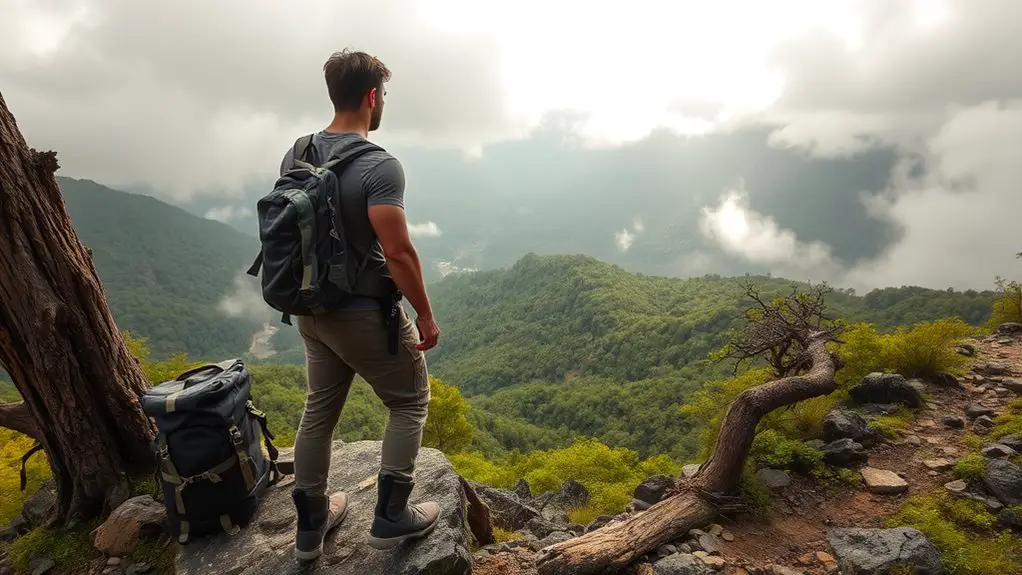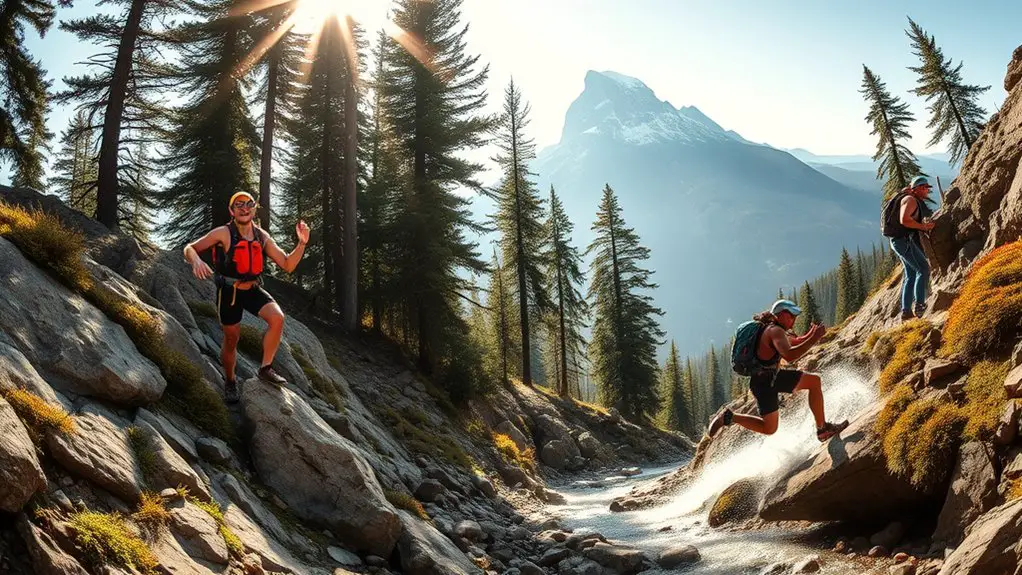To develop wilderness endurance, you need to focus on both physical and mental aspects. Start with progressive training, combining hikes and cardio workouts to build stamina. Incorporate strength training and cross-training activities. Don't forget nutrition; eat balanced meals rich in complex carbs, healthy fats, and lean proteins to fuel your adventures. Plus, work on mental resilience through mindfulness and visualization. There's more to discover about enhancing your outdoor experiences and staying prepared for the unpredictability of nature.
Understanding Wilderness Endurance
When you venture into the wilderness, understanding endurance is crucial for your survival and enjoyment. It's not just about physical strength; it's about mental resilience, too. You'll face challenges that test your limits, and knowing how to push through those moments can make all the difference. Endurance means adapting to the environment, whether it's coping with harsh weather or maneuvering rugged terrain. It's about maintaining a steady pace, staying focused, and keeping your spirits high, even when the going gets tough.
Moreover, endurance isn't achieved overnight. It's a gradual process that involves learning to listen to your body and respecting its needs. Embrace the journey; each step builds your confidence and prepares you for future adventures. Remember, the freedom you seek in the wild comes with the understanding that endurance is your ally, helping you thrive in nature's embrace while you savor every moment. Additionally, cultivating mental toughness allows you to explore your limits without fear or doubt.
Building Physical Stamina
To build your physical stamina for wilderness endurance, you'll want to focus on progressive training techniques that gradually increase your workload. Incorporating cross-training activities can also help diversify your workouts and prevent burnout. Don't forget that proper nutrition plays an essential role in sustaining your energy levels during those long treks. Additionally, building stamina is a necessity for excelling in high-intensity sports.
Progressive Training Techniques
Building physical stamina requires a strategic approach, especially if you're preparing for the demands of wilderness endurance. Start by gradually increasing your workout intensity and duration. Incorporate longer hikes, runs, or bike rides into your weekly routine, pushing your limits a little more each time. Don't forget to mix in interval training; short bursts of high-intensity exercises can dramatically boost your endurance. Listen to your body—rest is just as important as training. Allow time for recovery to prevent burnout and injury. Set clear, achievable goals along the way to keep your motivation high. Embrace the freedom that comes with each improvement, and soon you'll find yourself thriving in the wilderness, ready for any adventure that awaits.
Cross-Training Activities
Incorporating cross-training activities into your routine can considerably enhance your physical stamina for wilderness endurance. By mixing up your workouts, you not only prevent boredom but also engage different muscle groups, which helps in building overall strength and resilience. Think about activities like cycling, swimming, or yoga. These exercises can complement your hiking or backpacking efforts, improving your cardiovascular fitness while promoting flexibility and core strength. You might also consider interval training, which can boost your endurance and speed, essential for those challenging terrains. Remember, the goal is to keep your body adaptable and ready for whatever adventure lies ahead. So, embrace variety in your training—your future wilderness experiences will thank you for it!
Nutrition for Endurance
While you push your limits in the wilderness, proper nutrition plays an essential role in sustaining your energy levels and enhancing your performance. Fuel your adventures with a balanced mix of carbohydrates, proteins, and healthy fats. Carbs are your go-to source for quick energy, so load up on whole grains, fruits, and veggies. Don't forget to include lean proteins like nuts, seeds, and legumes to support muscle recovery. Hydration is crucial too; always carry water or electrolyte-rich drinks to keep you sharp. Snack wisely by grabbing energy bars or trail mix during breaks. Listen to your body—understanding its needs is key to thriving in nature. With the right nutrition, you'll feel unstoppable as you embrace your wild journey.
Mental Resilience Techniques
To endure the challenges of the wilderness, you need mental resilience just as much as physical strength. Techniques like positive visualization, mindfulness, and embracing discomfort can help you push through tough moments. Let's explore how these strategies can elevate your endurance and enhance your outdoor experiences. Additionally, incorporating mindfulness techniques into your routine can help reduce anxiety and improve your focus during challenging situations.
Positive Visualization Strategies
Positive visualization strategies can markedly enhance your mental resilience, especially in challenging wilderness situations. By picturing yourself thriving in tough conditions, you can build confidence and reduce anxiety. Start by imagining your ideal scenario: the crisp air, the vibrant landscape, and your own strong, capable self maneuvering through it all. Focus on the feelings of freedom and empowerment that come with overcoming obstacles. When faced with difficulties, close your eyes and revisit that mental image. Allow it to fuel your determination and drive. Regularly practicing this technique helps rewire your brain, making it easier to tackle real challenges ahead. So, embrace this powerful tool and let it guide you to freedom and endurance in the wilderness.
Mindfulness and Meditation Practices
As you navigate the challenges of the wilderness, incorporating mindfulness and meditation practices can markedly bolster your mental resilience. These techniques help you stay present, reduce anxiety, and enhance your overall well-being. Here's a simple table to guide you through different mindfulness practices:
| Practice | Duration | Benefits |
|---|---|---|
| Deep Breathing | 5-10 minutes | Reduces stress, calms mind |
| Body Scan | 10-15 minutes | Increases body awareness |
| Nature Walk | 30 minutes | Connects you to the environment |
| Guided Meditation | 10-20 minutes | Focuses thoughts, promotes relaxation |
| Journaling | 15 minutes | Reflects experiences, clarifies thoughts |
Embracing Discomfort and Challenge
Embracing discomfort and challenge is essential for building mental resilience, especially in the wilderness where unpredictability reigns. When you step outside your comfort zone, you're not just testing your limits; you're uncovering your true potential. Think about those moments when the trail gets tough or the weather turns. Instead of shying away, lean into the challenge. Each struggle is an opportunity to grow stronger.
Practice reframing your mindset—view discomfort as a teacher, not an enemy. Whether it's a steep climb or a cold night, remind yourself that overcoming these obstacles fuels your spirit of adventure. Each challenge faced is a step towards freedom, allowing you to embrace life's uncertainties with confidence and joy. So, get out there and welcome the wild!
Developing Essential Outdoor Skills
While you might feel overwhelmed by the vastness of the wilderness, developing essential outdoor skills is key to gaining confidence and resilience in nature. Start with navigation—learn to read maps and use a compass. This'll help you explore without fear of getting lost. Next, focus on fire-making techniques; mastering this skill not only provides warmth but also boosts your morale.
Practicing shelter-building can also be a game-changer. Knowing how to create a safe haven from the elements guarantees you can adapt and thrive. Additionally, honing your first aid skills equips you to handle emergencies, giving you peace of mind as you roam free.
Lastly, familiarize yourself with local flora and fauna. Understanding your surroundings deepens your connection to the wild. By developing these skills, you'll embrace the freedom of the wilderness, empowering yourself to enjoy every adventure with confidence.
Nutrition for Endurance
To sustain your energy in the wilderness, understanding nutrition for endurance is essential. You won't just need calories; you'll need the right kind of fuel to keep you going. Focus on nutrient-dense foods that provide lasting energy and support your adventurous spirit. Here are some key elements to include in your diet:
- Complex Carbohydrates: Think whole grains, oats, and sweet potatoes for steady energy.
- Healthy Fats: Nuts, seeds, and avocados will keep you feeling satisfied and focused.
- Lean Proteins: Chicken, fish, or legumes help repair muscles and maintain stamina.
- Electrolytes: Don't forget salt, potassium, and magnesium to stay hydrated and balanced.
- Hydration: Water's your best friend; keep sipping to support overall performance.
To enhance performance, consider the role of macronutrients for endurance in your diet, ensuring you are fueling your body effectively.
With the right nutrition, you'll embrace your freedom in the wild, feeling energized and ready for whatever adventures lie ahead!
Training Regimens for Hikers
As you prepare for your wilderness adventures, establishing a solid training regimen is vital for enhancing your hiking endurance and overall performance. Start with cardio workouts like running, cycling, or swimming to build your aerobic capacity. Aim for at least three sessions a week, gradually increasing intensity and duration. Incorporate strength training, focusing on your legs, core, and back, to tackle those steep trails confidently. Bodyweight exercises like squats and lunges are great for building functional strength.
Don't forget to practice hiking itself! Take regular day hikes with a weighted backpack to mimic your adventure load, and gradually increase the distance. Include varied terrains to adapt your body to different challenges. Additionally, staying hydrated is crucial for maintaining optimal performance during your training and hikes. Finally, listen to your body and allow for rest and recovery—it's vital for preventing injuries. With commitment and consistency, you'll find yourself ready to embrace the freedom of the wild with endurance and strength.
Preparing for Unpredictable Weather
When you're out in the wilderness, being unprepared for unpredictable weather can quickly turn a great adventure into a challenging experience. To guarantee you're ready for anything Mother Nature throws your way, consider these essential tips:
- Layer Up: Wear moisture-wicking base layers, insulating mid-layers, and waterproof outer layers.
- Pack a Rain Jacket: A lightweight, breathable rain jacket can be a lifesaver in sudden downpours.
- Bring Extra Gear: Always have an extra pair of socks and gloves; wet feet or hands can ruin your experience.
- Stay Informed: Check the weather forecast regularly and be aware of changing conditions.
- Adjust Your Plan: Be flexible with your itinerary. If storms are looming, it might be best to seek shelter or head back.
Embracing the unknown is part of the thrill, but being prepared keeps your spirit alive and your adventure on track.
Frequently Asked Questions
What Gear Is Essential for Long Wilderness Trips?
For long wilderness trips, you'll want a sturdy tent, reliable cooking gear, quality sleeping bag, durable backpack, and appropriate clothing. Don't forget a first-aid kit and navigation tools; they're essential for your adventurous spirit!
How Can I Recover After a Long Hike?
After a long hike, focus on hydration and nutrition. Rest those tired muscles, stretch gently, and consider a warm bath. Listen to your body; it'll tell you when it's ready for the next adventure.
Are There Specific Stretches for Hikers?
Yes, there're specific stretches for hikers. Focus on your hamstrings, calves, and hip flexors. Stretching improves flexibility, reduces soreness, and enhances your freedom to explore. So, embrace those stretches and feel the benefits on your next adventure!
How Do I Stay Motivated During Long Treks?
To stay motivated during long treks, set small goals, enjoy nature's beauty, and embrace the journey. Remember, each step brings freedom, so celebrate little victories and let the adventure fuel your spirit!
What Should I Do if I Encounter Wildlife?
If you stumble upon wildlife, don't panic! Stay calm, back away slowly, and remember, you're not a snack! Respect their space, and you'll keep your adventure alive—freedom's all about knowing when to tread lightly!




